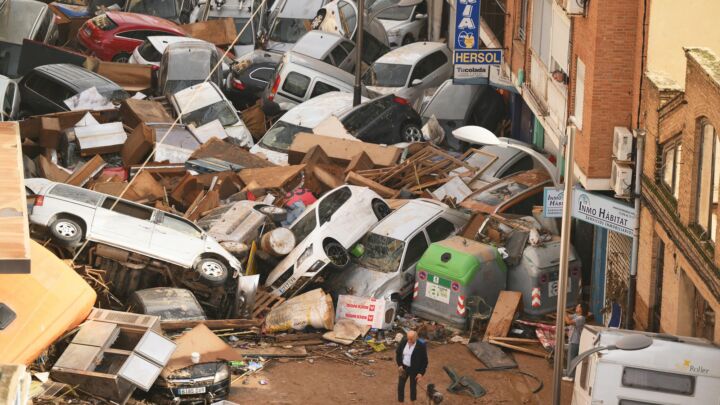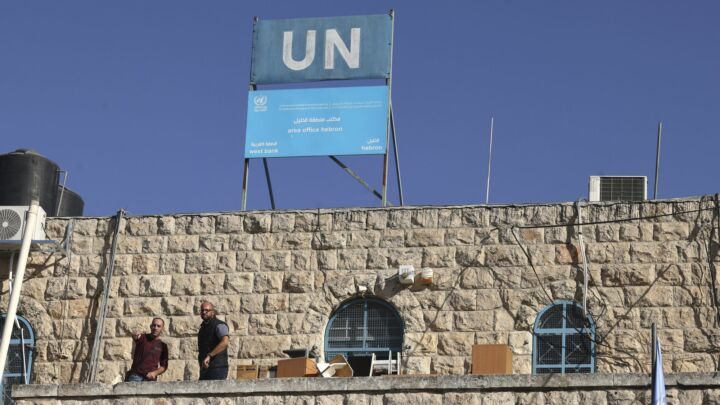Hans off Iraq!
How Hans Blix and other weapons inspectors paved the way for war.

Want to read spiked ad-free? Become a spiked supporter.
How have Hans Blix, the late David Kelly and other UN weapons inspectors become the darlings of the anti-war movement when they were central to the case for waging war on Iraq?
In sceptical-about-war circles and at Islington dinner parties it has become de rigueur to declare that if only Blix and co had been allowed to complete their inspections, ‘war could have been avoided’. Following the publication of the Iraq Survey Group’s report in early October – which concluded that, contrary to President Bush’s pre-war claims that Saddam had ‘weapons of mass murder’, in fact he had no stockpiles of chemical, biological or nuclear weapons – former UK cabinet minister Robin Cook said: ‘It is a tragic mistake that instead of letting the inspectors finish the job, we instead opted for an invasion which turned out to be based on false intelligence.’ (1)
This might make for a nice fairytale version of recent events, complete with clashes between big bad Bush’n’Blair and honest-as-you-like inspectors – but that’s all it is, a fairytale. The UN inspectors didn’t provide an alternative to war; they laid the ground for war. From 1998, when the first lot of inspectors left Iraq, to the eve of Gulf War II in 2003, inspectors raised suspicion after suspicion about the Ba’athists, describing them as ‘bastards’ and ‘moral lepers’ in charge of a ‘terribly dangerous rogue state’, and accusing them of trying to develop the Plague, anthrax bombs, smallpox, other viral programmes and, in the words of one author, ‘God knows what else’ (2). Bush and Blair pulled the trigger in March 2003, but it was the inspectors who helped them load the gun.
Today, in the wake of the Iraq Survey Group’s findings (or non-findings), Blix says Saddam probably destroyed his WMD 10 years ago, after the first Gulf War. In his book Disarming Iraq: The Search for Weapons of Mass Destruction, published earlier this year, he asks why Bush and Blair so blindly believed that Saddam had WMD when both UNSCOM (the team that inspected Iraq from 1991 to 1998) and UNMOVIC (the second team, headed by Blix, which inspected Iraq in 2002) failed to find any (3). He neglects to mention that the inspectors (including himself) didn’t take their failure to find WMD as evidence that Iraq didn’t have any, much less that they had been destroyed 10 years previously, but as a sign that the liars must be hiding them.
The period between 1998, when UNSCOM officials left Iraq as then US President Bill Clinton and UK prime minister Tony Blair launched their bombing campaign Operation Desert Fox, and 2002, when under Blix the inspectors returned, is referred to in weapons inspection circles as the ‘dark years’. During this time the inspectors, bitter at having to leave Iraq, tried desperately to convince the world that Saddam was still a threat that needed to be neutered. They gave public speeches and contributed to books and newspaper articles on Iraq’s alleged weapons programmes. Some of them helped Tom Mangold and Jeff Goldberg with their book Plague Wars: A True Story of Biological Warfare, first published in 1999 and republished in 2000. That book describes Iraq as ‘one of the most dangerous rogue states in the world today’, and as the possible site of the ‘first biological war of the millennium’. Iraq is an ‘immediate danger’, it declared (4).
Britain’s own David Kelly – the Ministry of Defence scientist who committed suicide in July 2003 after being fingered as the BBC’s source for its claims that the government ‘sexed up’ its Iraq dossier – was often at the forefront of this shrill scaremongering in the ‘dark years’. He told Mangold and Goldberg that Iraq had been working on ‘three viral programmes – camel pox, rotaviruses and haemorrhagic conjunctivitis…a robust, indestructible little virus which you can spray on clothes and skin’. He also said that Iraq might be trying to develop the Plague and that Iraqis ‘could send a couple of Scuds with anthrax warheads against Israel or Kuwait today. They can easily produce the 145 litres of anthrax per warhead’ (5). Kelly’s comments were published in 1999 and 2000 – yet we now know from the Iraq Survey Group that Iraq had no biological and chemical weapons programme, and from Hans Blix himself that Iraq most likely destroyed its WMD 10 years ago.
Another British weapons inspector, Hamish Killip, also said things about Iraq which have since been rubbished. He accused the Iraqis of developing remote-controlled flying vehicles with ‘biological warfare drop-tanks filled with anthrax’, describing these as ‘incredibly simple and incredibly awful…the most ghastly weapon, like the Nazis’ V1 doodlebug’ (6). Richard Butler, the former head of UNSCOM who had been accused of colluding with the Americans and British over Operation Desert Fox, told Mangold and Goldberg that the Iraqis still ‘hold keys to the biological warfare box’. He has also said, ‘I know what these bastards [the Iraqis] are like’; Mangold pointed out that ‘it is no secret that Butler finds the Iraqi regime deeply repugnant, run by moral lepers’ (7).
Indeed, even when Bush officials went through a brief spell in 2001 of claiming that Saddam was no longer a threat to Western civilisation and had wound down his WMD programmes, the inspectors continued to talk up Saddam’s threat. On 24 February 2001, US secretary of state Colin Powell said that Saddam ‘has not developed any significant capability with respect to weapons of mass destruction. He is unable to project conventional power against his neighbours’ (8). In July 2001 national security adviser Condoleezza Rice said the Bush administration had managed to ‘keep arms from [Saddam]. His military forces have not been rebuilt’ (9).
Around that very time, David Kelly and other inspectors were offering advice and insights to Judith Miller for her book Germs: The Ultimate Weapon, published towards the end of 2001. Miller is the arch pro-war reporter on the New York Times, who has recently been ridiculed for her ‘wretched reporting’ in the run-up to and during the Iraq war, when she relied on highly dubious sources to convince readers that Saddam really did have evil weapons. In Germs, she writes of Iraq’s attempts to acquire anthrax and other germs (10). Kelly continued to provide Miller with ‘insights’ up to December 2002, three months before the start of the war and seven months before he committed suicide. On 3 December 2002, Miller wrote a piece for the NYT in which she claimed that Iraq had ‘obtained a particularly virulent strain of smallpox from a Russian scientist who worked in a smallpox lab in Moscow…’ – for which Kelly was one of the few named sources (10).
The final nail in Iraq’s coffin was provided by Hans Blix. Today he takes an ‘I told you so’ approach to Bush and Blair, contrasting his own rational approach to Iraq’s alleged WMD with America and Britain’s hysterical warmongering, and declaring that Saddam got shot of his WMD 10 years ago. He’s changed his tune. At the end of January 2003, six weeks before Bush and Blair launched their war, Blix said no such thing about Iraq having no WMD. Instead, like other weapons inspectors before him, he raised suspicions and, in the words of one report, ‘buttressed’ the pro-war campaign (11).
In his speech to the UN Security Council on 27 January 2003, Blix asked awkward ‘questions that need to be answered’. On chemical weapons he raised the problem that: ‘Some 6,500 chemical bombs containing 1,000 tons of chemical agents and “several thousand” chemical rocket warheads are unaccounted for…. Inspectors found a “laboratory quantity” of thiodiglycol, a precursor of mustard gas…. Iraq has prepared equipment at a chemical plant previously destroyed by the UN….’ On biological weapons he said: ‘Iraq has declared that it produced about 8,500 litres of [anthrax], which it states it unilaterally destroyed in the summer of 1991. But Iraq has provided little evidence for this production and no convincing evidence for its destruction.’ He also warned, ominously, that Iraq’s anthrax ‘might still exist’ (12).
Only it didn’t. The Iraq Survey Group now says that Iraq had no active chemical or biological weapons programme. So Blix was as wrong as Bush, Blair and everyone else who said Saddam had weapons that posed a threat to world peace.
Indeed, Blix approached the inspections with the attitude that if he and his team didn’t find WMD that still wouldn’t be evidence that said WMD did not exist. Before setting off to inspect Iraq, he told a reporter that ‘not seeing something, not seeing an indication of something, does not lead automatically to the conclusion that there is nothing’ (13). He put Iraqis in a no-win situation – if he found weapons there would be war, and if he didn’t find weapons, well, there might still be war. When he finally delivered his report to the UN he tried to play to both camps, raising suspicions about Saddam’s wicked intentions while also calling for further inspections to establish the truth. The pro-war lobby saw what they wanted to see, with one reporter claiming that Blix’s report ‘greatly strengthened the American and British case for war’ (14).
Many wonder why Bush and Blair launched a war on the basis of dodgy intelligence; why they focused exclusively on the threat from Saddam’s WMD rather than on his human rights records; how they could declare with such moral certainty that Saddam had missiles, chemicals and poisons, and that they might be used at any moment in a new terrifying bio-war for the new millennium. Where could they have got crazy ideas like that?
Read on:
spiked-issue: War on Iraq
(1) UK government defends invasion of Iraq despite new report showing no WMD found, InfoBeat, October 2004
(2) Plague Wars: A True Story of Biological Warfare, Tom Mangold and Jeff Goldberg, Pan Books, 1999
(3) Disarming Iraq: The Search for Weapons of Mass Destruction, Hans Blix, Pantheon, 2004
(4) Plague Wars: A True Story of Biological Warfare, Tom Mangold and Jeff Goldberg, Pan Books, 1999
(5) Plague Wars: A True Story of Biological Warfare, Tom Mangold and Jeff Goldberg, Pan Books, 1999
(6) Plague Wars: A True Story of Biological Warfare, Tom Mangold and Jeff Goldberg, Pan Books, 1999
(7) Plague Wars: A True Story of Biological Warfare, Tom Mangold and Jeff Goldberg, Pan Books, 1999
(8) 2001: Powell and Rice declare Iraq has no WMD and is not a threat, Memory Hole, 7 October 2003
(9) 2001: Powell and Rice declare Iraq has no WMD and is not a threat, Memory Hole, 7 October 2003
(10) Germs: The Ultimate Weapon, Judith Miller, Stephen Engelberg, William Broad, Simon & Schuster, 2001
(11) The damning of Saddam, Robin Gedye, Toby Harnden in Washington and Toby Helm, Daily Telegraph, 28 January 2003
(12) An update on inspection, Hans Blix, United Nations Monitoring, Verification and Inspection Commission, 27 January 2004
(13) The anthrax hunter, Julian Borger, Guardian, 10 April 2002
(14) The damning of Saddam, Robin Gedye, Toby Harnden in Washington and Toby Helm, Daily Telegraph, 28 January 2003
Celebrate 25 years of spiked!
A media ecosystem dominated by a handful of billionaire owners, bad actors spreading disinformation online and the rich and powerful trying to stop us publishing stories. But we have you on our side. help to fund our journalism and those who choose All-access digital enjoy exclusive extras:
- Unlimited articles in our app and ad-free reading on all devices
- Exclusive newsletter and far fewer asks for support
- Full access to the Guardian Feast app
If you can, please support us on a monthly basis and make a big impact in support of open, independent journalism. Thank you.







Comments
Want to join the conversation?
Only spiked supporters and patrons, who donate regularly to us, can comment on our articles.